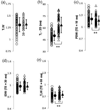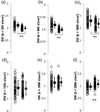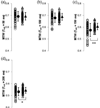Sensitivity and specificity of univariate MRI analysis of experimentally degraded cartilage under clinical imaging conditions
- PMID: 25327944
- PMCID: PMC4402115
- DOI: 10.1002/jmri.24773
Sensitivity and specificity of univariate MRI analysis of experimentally degraded cartilage under clinical imaging conditions
Abstract
Background: To evaluate the sensitivity and specificity of classification of pathomimetically degraded bovine nasal cartilage at 3 Tesla and 37°C using univariate MRI measurements of both pure parameter values and intensities of parameter-weighted images.
Methods: Pre- and posttrypsin degradation values of T1 , T2 , T2 *, magnetization transfer ratio (MTR), and apparent diffusion coefficient (ADC), and corresponding weighted images, were analyzed. Classification based on the Euclidean distance was performed and the quality of classification was assessed through sensitivity, specificity and accuracy (ACC).
Results: The classifiers with the highest accuracy values were ADC (ACC = 0.82 ± 0.06), MTR (ACC = 0.78 ± 0.06), T1 (ACC = 0.99 ± 0.01), T2 derived from a three-dimensional (3D) spin-echo sequence (ACC = 0.74 ± 0.05), and T2 derived from a 2D spin-echo sequence (ACC = 0.77 ± 0.06), along with two of the diffusion-weighted signal intensities (b = 333 s/mm(2) : ACC = 0.80 ± 0.05; b = 666 s/mm(2) : ACC = 0.85 ± 0.04). In particular, T1 values differed substantially between the groups, resulting in atypically high classification accuracy. The second-best classifier, diffusion weighting with b = 666 s/mm(2) , as well as all other parameters evaluated, exhibited substantial overlap between pre- and postdegradation groups, resulting in decreased accuracies.
Conclusion: Classification according to T1 values showed excellent test characteristics (ACC = 0.99), with several other parameters also showing reasonable performance (ACC > 0.70). Of these, diffusion weighting is particularly promising as a potentially practical clinical modality. As in previous work, we again find that highly statistically significant group mean differences do not necessarily translate into accurate clinical classification rules.
Keywords: bovine nasal cartilage; classification; osteoarthritis; quantitative MRI; sensitivity; specificity.
© 2014 Wiley Periodicals, Inc.
Figures





References
-
- Regatte RR, Akella SV, Reddy R. Depth-dependent proton magnetization transfer in articular cartilage. J Magn Reson Imaging. 2005;22:318–323. - PubMed
-
- Mlynarik V, Sulzbacher I, Bittsansky M, Fuiko R, Trattnig S. Investigation of apparent diffusion constant as an indicator of early degenerative disease in articular cartilage. Journal of Magnetic Resonance Imaging. 2003;17:440–444. - PubMed
-
- Nissi MJ, Toyras J, Laasanen MS, et al. Proteoglycan and collagen sensitive MRI evaluation of normal and degenerated articular cartilage. Journal of Orthopaedic Research. 2004;22:557–564. - PubMed
Publication types
MeSH terms
Grants and funding
LinkOut - more resources
Full Text Sources
Other Literature Sources
Medical
Research Materials

